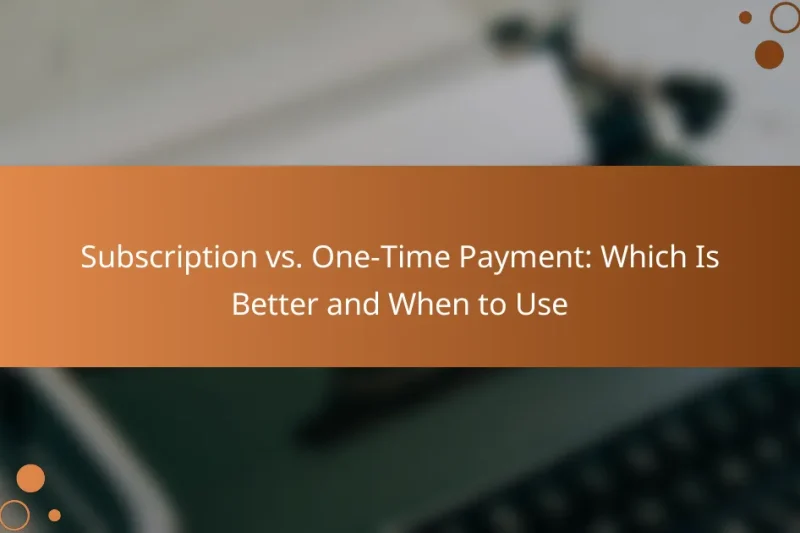When deciding between subscription and one-time payment models, it’s essential to consider your needs and usage … Subscription vs. One-Time Payment: Which Is Better and When to UseRead more
Digital Products: Pricing Models
Digital products have become increasingly popular, and selecting the right pricing model is crucial for success. Common approaches include subscription-based, one-time purchase, freemium, pay-per-use, and tiered pricing, each catering to different consumer needs and business goals. Understanding your audience and market dynamics can help you choose a strategy that maximizes revenue and enhances customer satisfaction.
Free Trials: Conversion Rates, Customer Engagement and Course Accessibility
Free trials are a powerful marketing tool that can significantly enhance conversion rates by allowing potential … Free Trials: Conversion Rates, Customer Engagement and Course AccessibilityRead more
What are the common pricing models for digital products?
Common pricing models for digital products include subscription-based, one-time purchase, freemium, pay-per-use, and tiered pricing. Each model has unique characteristics that cater to different consumer preferences and business strategies.
Subscription-based pricing
Subscription-based pricing involves charging customers a recurring fee to access a digital product or service. This model is popular among software companies and streaming services, allowing users to pay monthly or annually for ongoing access.
Key considerations include customer retention and churn rates, as businesses need to provide continuous value to justify the recurring cost. Examples include platforms like Netflix or Adobe Creative Cloud, which offer various subscription tiers based on features and usage.
One-time purchase pricing
One-time purchase pricing requires customers to pay a single fee to acquire a digital product permanently. This model is straightforward and often used for software applications, eBooks, or online courses.
While it can generate immediate revenue, businesses must ensure that the product meets customer expectations to avoid refunds or negative reviews. Examples include purchasing a software license or downloading an eBook from an online retailer.
Freemium model
The freemium model offers basic features for free while charging for premium features or services. This approach attracts a large user base, with the goal of converting free users into paying customers over time.
Successful freemium models often include enticing upgrades that enhance user experience, such as additional storage or advanced functionalities. Popular examples include Spotify and Dropbox, which provide free access with optional paid upgrades.
Pay-per-use pricing
Pay-per-use pricing charges customers based on their actual usage of a product or service. This model is commonly found in cloud computing and online services where costs are directly tied to consumption.
Businesses must clearly communicate pricing structures to avoid customer confusion. Examples include Amazon Web Services, where users pay for computing power and storage based on their specific needs.
Tiered pricing
Tiered pricing offers multiple pricing levels based on different features or usage limits. This model allows businesses to cater to a range of customer needs and budgets, encouraging upgrades as users grow.
Each tier typically includes a set of features that increase in value, making it easier for customers to choose the option that best fits their requirements. Examples include SaaS platforms like HubSpot, which provide various tiers for marketing, sales, and customer service tools.
How to choose the right pricing model for digital products?
Selecting the right pricing model for digital products involves understanding your audience, analyzing competitors, and evaluating the value of your product. A well-chosen pricing strategy can enhance sales and customer satisfaction while maximizing revenue.
Understand your target audience
Identifying your target audience is crucial for selecting an effective pricing model. Consider factors such as demographics, purchasing behavior, and income levels. For instance, a subscription model may appeal more to younger consumers who prefer low upfront costs.
Engage with potential customers through surveys or focus groups to gather insights on their willingness to pay. This feedback can guide you in setting a price point that resonates with your audience.
Analyze competitor pricing strategies
Researching competitor pricing strategies helps you position your product effectively in the market. Look at how similar digital products are priced and the models they use, such as one-time purchases, subscriptions, or freemium options.
Consider creating a comparison table to visualize different pricing tiers and features offered by competitors. This can highlight gaps in the market that your product can fill or reveal pricing trends that you should follow.
Evaluate product value and features
Assessing the value and features of your digital product is essential for determining the right pricing model. Consider what unique benefits your product offers and how it solves problems for users. Products with advanced features may justify higher prices or premium subscription tiers.
Additionally, think about the costs associated with delivering your product, including development, maintenance, and customer support. Ensure that your pricing model covers these costs while remaining attractive to customers.
What are the advantages of subscription pricing for digital products?
Subscription pricing offers several advantages for digital products, including a steady revenue stream, enhanced customer loyalty, and opportunities for additional sales. These benefits can significantly impact a business’s growth and sustainability.
Predictable revenue stream
One of the main advantages of subscription pricing is the predictable revenue it generates. Businesses can forecast income more accurately, allowing for better budgeting and resource allocation. This stability is particularly beneficial for startups and small businesses that need to manage cash flow effectively.
For example, a software company charging $10 per month for its service can expect to earn $120 per customer annually. If they acquire 100 subscribers, that translates to $12,000 in predictable revenue each year.
Increased customer retention
Subscription models often lead to higher customer retention rates compared to one-time purchases. Customers are more likely to stay engaged with a product they pay for regularly, fostering a sense of commitment. This ongoing relationship can reduce churn rates, which is crucial for long-term profitability.
To enhance retention, businesses should focus on delivering consistent value through updates, customer support, and community engagement. For instance, offering exclusive content or features to subscribers can keep them invested in the service.
Opportunity for upselling
Subscription pricing creates opportunities for upselling additional products or services. Once customers are committed to a subscription, they may be more open to purchasing add-ons or premium features that enhance their experience. This can significantly increase the average revenue per user.
For example, a streaming service might offer a basic subscription with ads and provide an ad-free premium option at a higher price. By highlighting the benefits of the premium service, businesses can effectively encourage existing subscribers to upgrade.
What are the challenges of one-time purchase pricing?
One-time purchase pricing can lead to several challenges that affect revenue stability and customer relationships. These challenges include unpredictable revenue streams, high customer acquisition costs, and limited ongoing engagement with customers.
Revenue volatility
Revenue volatility is a significant challenge with one-time purchase pricing. Since income is generated only at the point of sale, businesses may experience fluctuating cash flow, making it difficult to predict future earnings. This unpredictability can hinder long-term planning and investment strategies.
To mitigate revenue volatility, businesses can consider implementing seasonal promotions or bundling products to encourage higher sales during slower periods. Offering limited-time discounts can also stimulate demand and create urgency among potential buyers.
Customer acquisition costs
High customer acquisition costs (CAC) are often associated with one-time purchase models. Businesses invest heavily in marketing and advertising to attract new customers, but without repeat purchases, these costs can quickly outweigh the revenue generated from a single sale. This can lead to unsustainable business practices.
To manage CAC, companies should focus on optimizing their marketing strategies, such as targeting specific demographics or utilizing cost-effective digital marketing channels. Building a strong brand presence can also help reduce reliance on paid advertising over time.
Limited customer engagement
One-time purchase pricing often results in limited customer engagement after the initial sale. Without ongoing interactions, businesses miss opportunities to build loyalty and encourage repeat purchases. This lack of engagement can lead to a decline in customer retention rates.
To enhance customer engagement, consider implementing follow-up strategies such as email marketing campaigns or loyalty programs. Providing valuable content, such as tutorials or updates, can also keep customers connected and encourage them to return for future purchases.
How does the freemium model work?
The freemium model offers basic features of a digital product for free while charging for premium features. This approach attracts a large user base, allowing companies to monetize a portion of those users who seek enhanced functionality or additional services.
Basic features for free
In the freemium model, users can access essential features at no cost, which helps in building a broad audience. These basic features often include core functionalities that allow users to experience the product’s value without any financial commitment.
For example, a cloud storage service might offer a limited amount of free storage space, enabling users to store and share files. This free access serves as an incentive for users to try the product and potentially upgrade later.
Premium features for a fee
Premium features in a freemium model are typically offered at a subscription or one-time fee, providing enhanced capabilities that go beyond the free version. These features can include advanced tools, increased storage, or ad-free experiences.
For instance, a music streaming service may allow free users to listen to a limited number of songs with ads, while premium subscribers enjoy unlimited access and offline listening. This tiered approach encourages users to consider upgrading as their needs evolve.
What factors influence pricing strategies for digital products?
Pricing strategies for digital products are influenced by various factors including market demand, competition, production costs, and customer perceptions. Understanding these elements helps businesses set prices that attract customers while ensuring profitability.
Market Demand
Market demand plays a crucial role in determining how much customers are willing to pay for digital products. High demand can justify higher prices, while low demand may require discounts or lower pricing to attract buyers. Businesses should analyze trends and customer feedback to gauge demand effectively.
Competition
The competitive landscape significantly impacts pricing strategies. If numerous similar products exist, companies may need to adopt competitive pricing to remain appealing. Conducting a competitive analysis helps identify pricing benchmarks and potential gaps in the market.
Production Costs
Understanding production costs is essential for setting sustainable prices. This includes development, maintenance, and marketing expenses. Companies should calculate their total costs and ensure that pricing covers these while allowing for a reasonable profit margin.
Customer Perceptions
Customer perceptions of value can greatly influence pricing. If a product is perceived as high-quality or unique, customers may be willing to pay a premium. Conducting surveys or focus groups can help businesses understand how their target audience views their products and adjust pricing accordingly.

